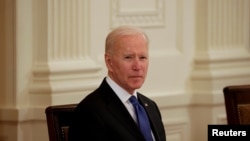The Biden administration released an outline Friday of how it wants the federal government to spend its money in Fiscal 2022, and if anyone was surprised by the contents, they must not have been paying attention.
Biden campaigned on promises to invest in education, jobs, health care and the environment, and the 58-page summary, covering the roughly one-third of federal spending considered discretionary — meaning not required by statute, like Medicare and Social Security payments — does precisely that.
The plan will delight many on the political left by restoring funding to agencies whose budgets had been slashed by former President Donald Trump. The Department of Education would see its budget leap by 41% compared to Fiscal 2021, the Commerce Department would get a 28% increase, the Department of Health and Human Services would get a 24% increase, and the Environmental Protection Agency’s budget would rise by 21%.
At the same time, some Democrats and virtually all Republicans will balk at a low rate of increase in defense spending. More broadly, Republicans will likely object to spending on Democratic priorities like clean energy research and efforts to alleviate economic inequality.
Budget ‘puts its money where its mouth is’
“This is what a budget looks like when the president thinks the government can be part of the solution,” said William Gale, a senior fellow in the Economic Studies Program at the Brookings Institution and a former senior economist for the Council of Economic Advisers under President George H.W. Bush.
“It's very aggressive in terms of education and housing and the Centers for Disease Control, right down the board,” Gale said. “It proposes that the government can help solve the problems in those areas, then it puts its money where its mouth is.”
The proposal is the first budget since 2013 not to be subject to spending caps that have kept discretionary defense spending and discretionary non-defense spending growing at approximately the same rate. With that constraint removed, the Biden administration is proposing a 16% increase in non-defense outlays to $769 billion and a much smaller 1.7% rise in defense spending to $753 billion.
“I'm not surprised, but I do think that this is going to be a major issue,” said G. William Hoagland, a senior vice president at the Bipartisan Policy Center.
Defense hawks unhappy
“This is going to be difficult, because even if there are Democratic members who would support the increases in non-defense discretionary spending, there are still Democrat defense hawks who would say this is not enough for defense,” said Hoagland, a former Republican staff director of the Senate Budget Committee who also worked as the director of budget and appropriations in the office of then-Senate Majority Leader Bill Frist. “So this is going to require some negotiations.”
Republicans, for their part, immediately zeroed in on the small rise in funding for the Pentagon.
In a joint statement, Senate Minority Leader Mitch McConnell and the top Republicans on the Senate’s Armed Services, Intelligence, Budget, and Appropriations committees said, “Cutting America’s defense budget completely undermines Washington Democrats’ tough talk on China and calls into question the administration’s willingness to confront the Chinese Communist Party.”
Liberal groups pleased
The Biden proposal was generally welcomed by groups that advocate for left-of-center priorities, who see it as a much-needed corrective to what they believe have been years of unnecessary austerity.
“What's most remarkable is that it's just a real different direction than we've seen over the last 10 years, where we've had this decade of underinvestment across a range of areas that are funded using discretionary funds,” said Tamara Fucile, a senior counselor to the Center on Budget and Policy Priorities.
“That decade of underinvestment has had significant ramifications on our economy,” Fucile said. “And here we're seeing the Biden administration propose funding levels that would really help strengthen our economy as we try to recover and build toward a more equitable economy following the pandemic.”
Budget hawks nervous
The proposal released Friday was not a full summary of the budget Biden would like to see passed, as it leaves out non-discretionary spending on Medicare, Medicaid, and Social Security, as well as revenue projections. This has groups concerned about the federal budget deficit waiting anxiously for more information.
“President Biden is entitled to pursue his policy agenda, but the expiration of discretionary spending caps shouldn’t mean the end of budget discipline,” said Maya MacGuineas, president of the Committee for a Responsible Federal Budget.
“Now is not the time to go on a spending spree, particularly without identifying offsetting tax increases or spending reductions,” MacGuineas said. “Importantly, discretionary spending encompasses only a third of the budget. We can’t truly evaluate the president’s agenda until we know how he’ll address the other two-thirds of the budget and what he will do on the other side of the ledger with taxes.”
Not so ‘dead on arrival'?
Whatever party the president belongs to, there is a long Washington tradition of White House budget requests being declared “dead on arrival” by lawmakers of the opposite party. This time around, though, the Democrats hold slim majorities in both the House and Senate and have the ability to pass a budget bill without Republican support.
That, plus the fact that many of the Biden administration’s proposals have broad public support, causes some experts to think there might be hope for a budget along the lines of what the administration proposes to become law.
“I think there's a good possibility that this budget is less dead than other budgets,” said Gale, of the Brookings Institution. “The administration is, I think, doing a very good job laying down markers in a lot of different areas. This is where they want to go; this is what they believe in. The message is consistent with what the Democrats are thinking, and actually what a lot of Republican voters are thinking even if Republican politicians are not.”
